University Training Program: Overcoming Barriers and Analysis
VerifiedAdded on 2020/05/28
|8
|1602
|195
Report
AI Summary
This report provides a comprehensive analysis of a training program, focusing on the challenges and solutions for effective implementation. It identifies five key barriers to training, including inertia, efficiency, and training mindset, and proposes strategies to overcome them. The report also delves into the need analysis process, covering organizational, person, and content analysis, alongside a cost-benefit analysis to justify the training investment. Furthermore, it explores various training methods and techniques, such as on-the-job and off-the-job training, providing examples and discussing their applications within the marketing sector. The report emphasizes the importance of understanding trainee mindsets and tailoring training to meet specific organizational goals and individual needs, offering valuable insights for improving training program effectiveness.
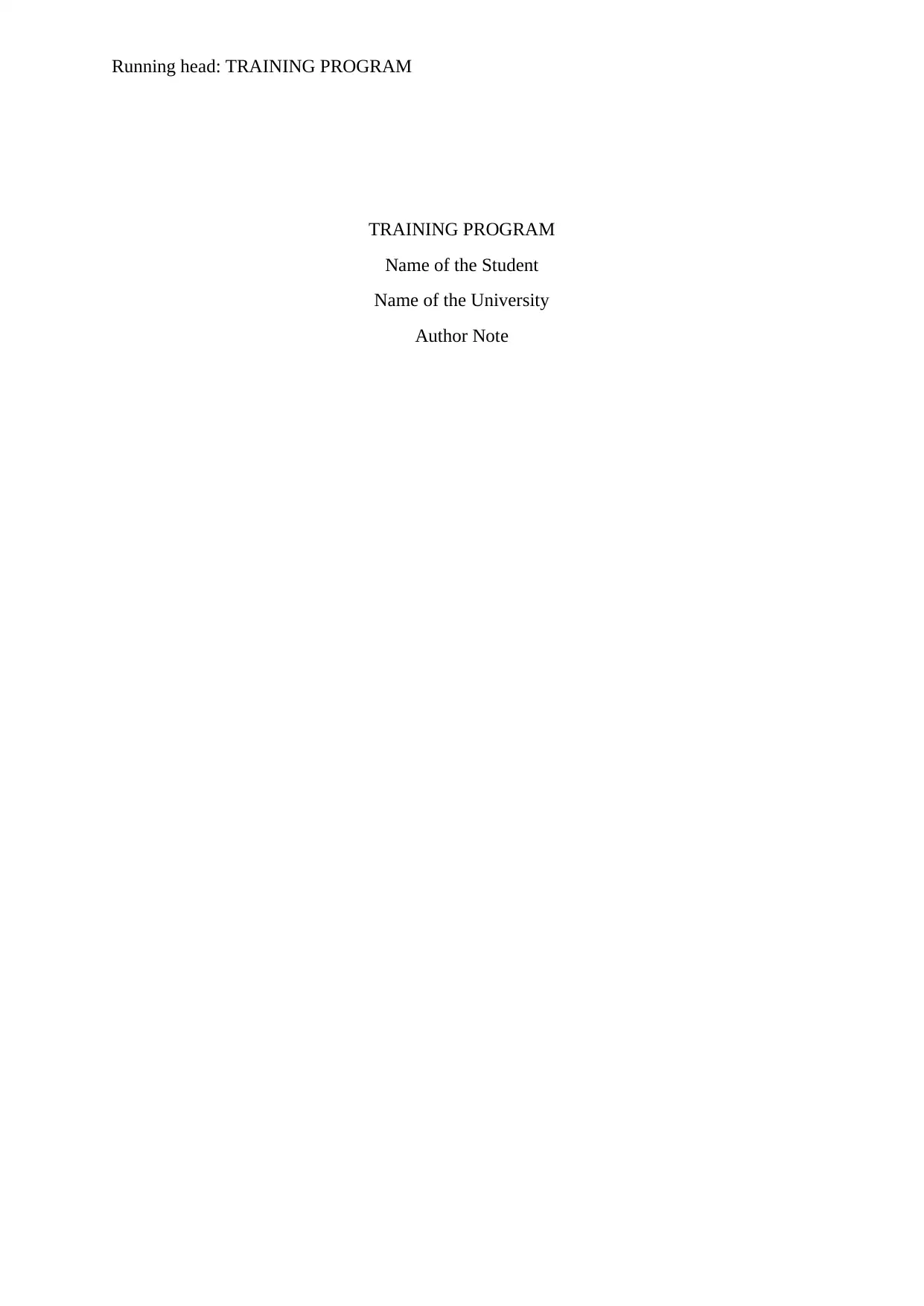
Running head: TRAINING PROGRAM
TRAINING PROGRAM
Name of the Student
Name of the University
Author Note
TRAINING PROGRAM
Name of the Student
Name of the University
Author Note
Paraphrase This Document
Need a fresh take? Get an instant paraphrase of this document with our AI Paraphraser
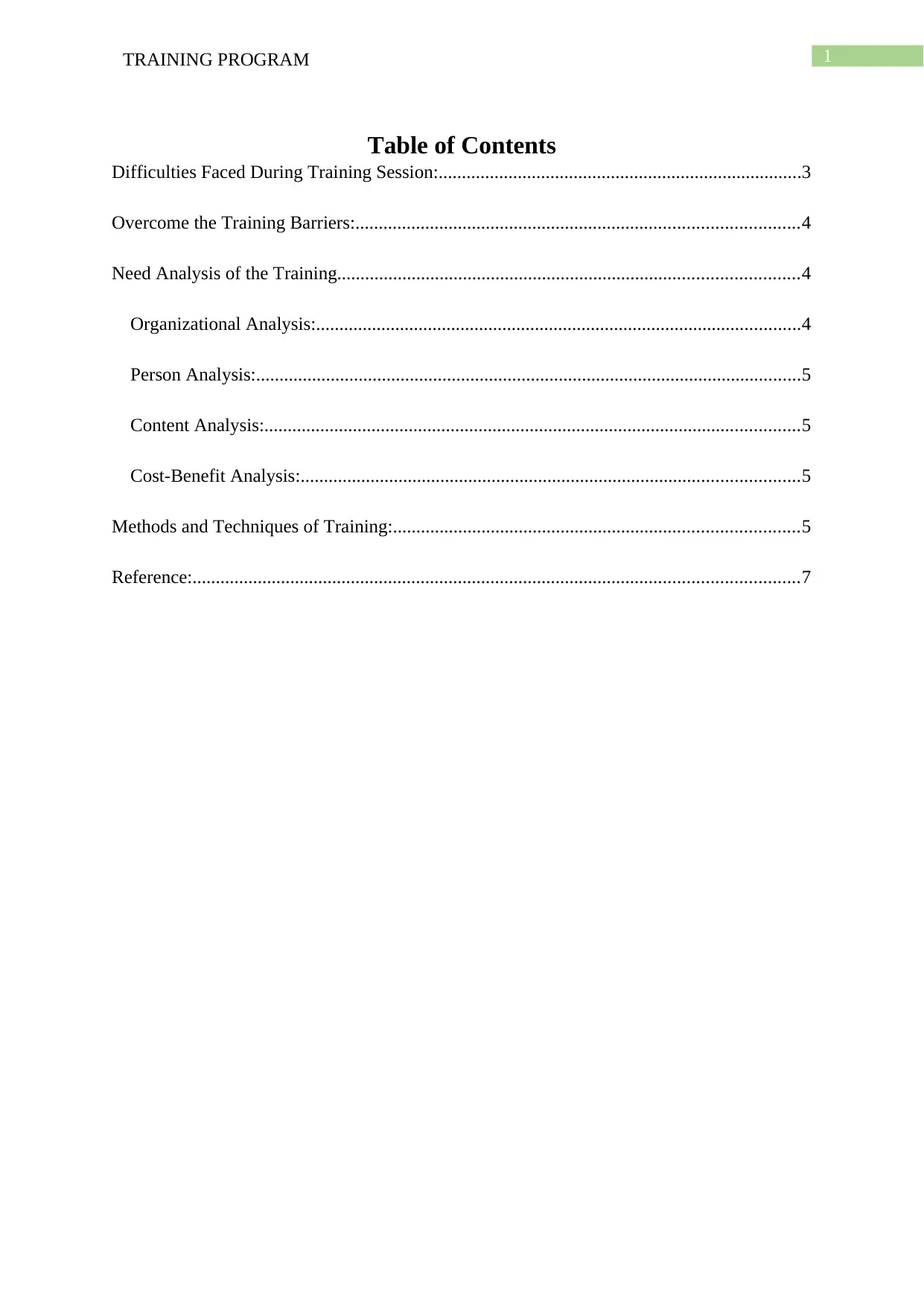
1TRAINING PROGRAM
Table of Contents
Difficulties Faced During Training Session:..............................................................................3
Overcome the Training Barriers:...............................................................................................4
Need Analysis of the Training...................................................................................................4
Organizational Analysis:........................................................................................................4
Person Analysis:.....................................................................................................................5
Content Analysis:...................................................................................................................5
Cost-Benefit Analysis:...........................................................................................................5
Methods and Techniques of Training:.......................................................................................5
Reference:..................................................................................................................................7
Table of Contents
Difficulties Faced During Training Session:..............................................................................3
Overcome the Training Barriers:...............................................................................................4
Need Analysis of the Training...................................................................................................4
Organizational Analysis:........................................................................................................4
Person Analysis:.....................................................................................................................5
Content Analysis:...................................................................................................................5
Cost-Benefit Analysis:...........................................................................................................5
Methods and Techniques of Training:.......................................................................................5
Reference:..................................................................................................................................7
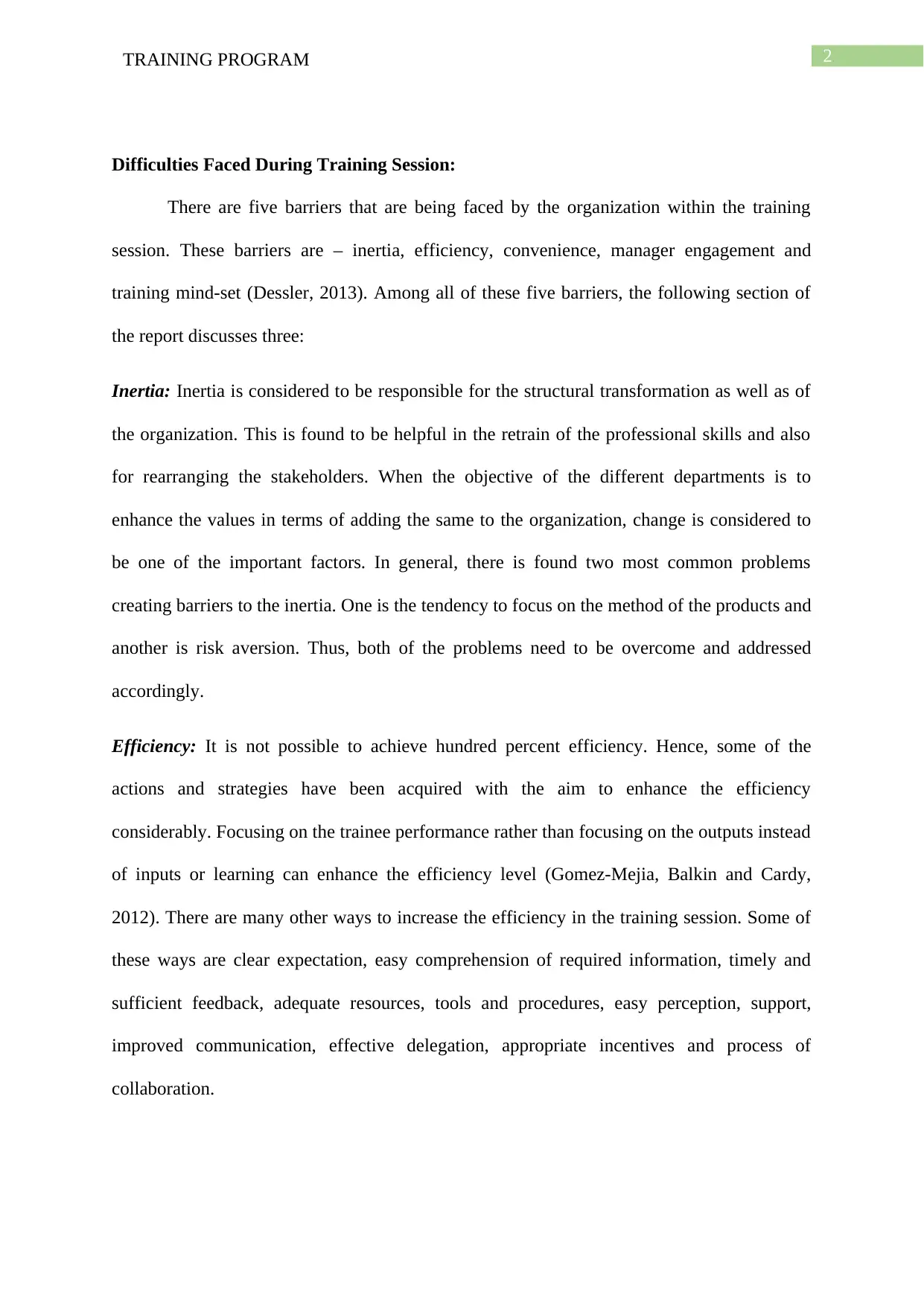
2TRAINING PROGRAM
Difficulties Faced During Training Session:
There are five barriers that are being faced by the organization within the training
session. These barriers are – inertia, efficiency, convenience, manager engagement and
training mind-set (Dessler, 2013). Among all of these five barriers, the following section of
the report discusses three:
Inertia: Inertia is considered to be responsible for the structural transformation as well as of
the organization. This is found to be helpful in the retrain of the professional skills and also
for rearranging the stakeholders. When the objective of the different departments is to
enhance the values in terms of adding the same to the organization, change is considered to
be one of the important factors. In general, there is found two most common problems
creating barriers to the inertia. One is the tendency to focus on the method of the products and
another is risk aversion. Thus, both of the problems need to be overcome and addressed
accordingly.
Efficiency: It is not possible to achieve hundred percent efficiency. Hence, some of the
actions and strategies have been acquired with the aim to enhance the efficiency
considerably. Focusing on the trainee performance rather than focusing on the outputs instead
of inputs or learning can enhance the efficiency level (Gomez-Mejia, Balkin and Cardy,
2012). There are many other ways to increase the efficiency in the training session. Some of
these ways are clear expectation, easy comprehension of required information, timely and
sufficient feedback, adequate resources, tools and procedures, easy perception, support,
improved communication, effective delegation, appropriate incentives and process of
collaboration.
Difficulties Faced During Training Session:
There are five barriers that are being faced by the organization within the training
session. These barriers are – inertia, efficiency, convenience, manager engagement and
training mind-set (Dessler, 2013). Among all of these five barriers, the following section of
the report discusses three:
Inertia: Inertia is considered to be responsible for the structural transformation as well as of
the organization. This is found to be helpful in the retrain of the professional skills and also
for rearranging the stakeholders. When the objective of the different departments is to
enhance the values in terms of adding the same to the organization, change is considered to
be one of the important factors. In general, there is found two most common problems
creating barriers to the inertia. One is the tendency to focus on the method of the products and
another is risk aversion. Thus, both of the problems need to be overcome and addressed
accordingly.
Efficiency: It is not possible to achieve hundred percent efficiency. Hence, some of the
actions and strategies have been acquired with the aim to enhance the efficiency
considerably. Focusing on the trainee performance rather than focusing on the outputs instead
of inputs or learning can enhance the efficiency level (Gomez-Mejia, Balkin and Cardy,
2012). There are many other ways to increase the efficiency in the training session. Some of
these ways are clear expectation, easy comprehension of required information, timely and
sufficient feedback, adequate resources, tools and procedures, easy perception, support,
improved communication, effective delegation, appropriate incentives and process of
collaboration.
⊘ This is a preview!⊘
Do you want full access?
Subscribe today to unlock all pages.

Trusted by 1+ million students worldwide
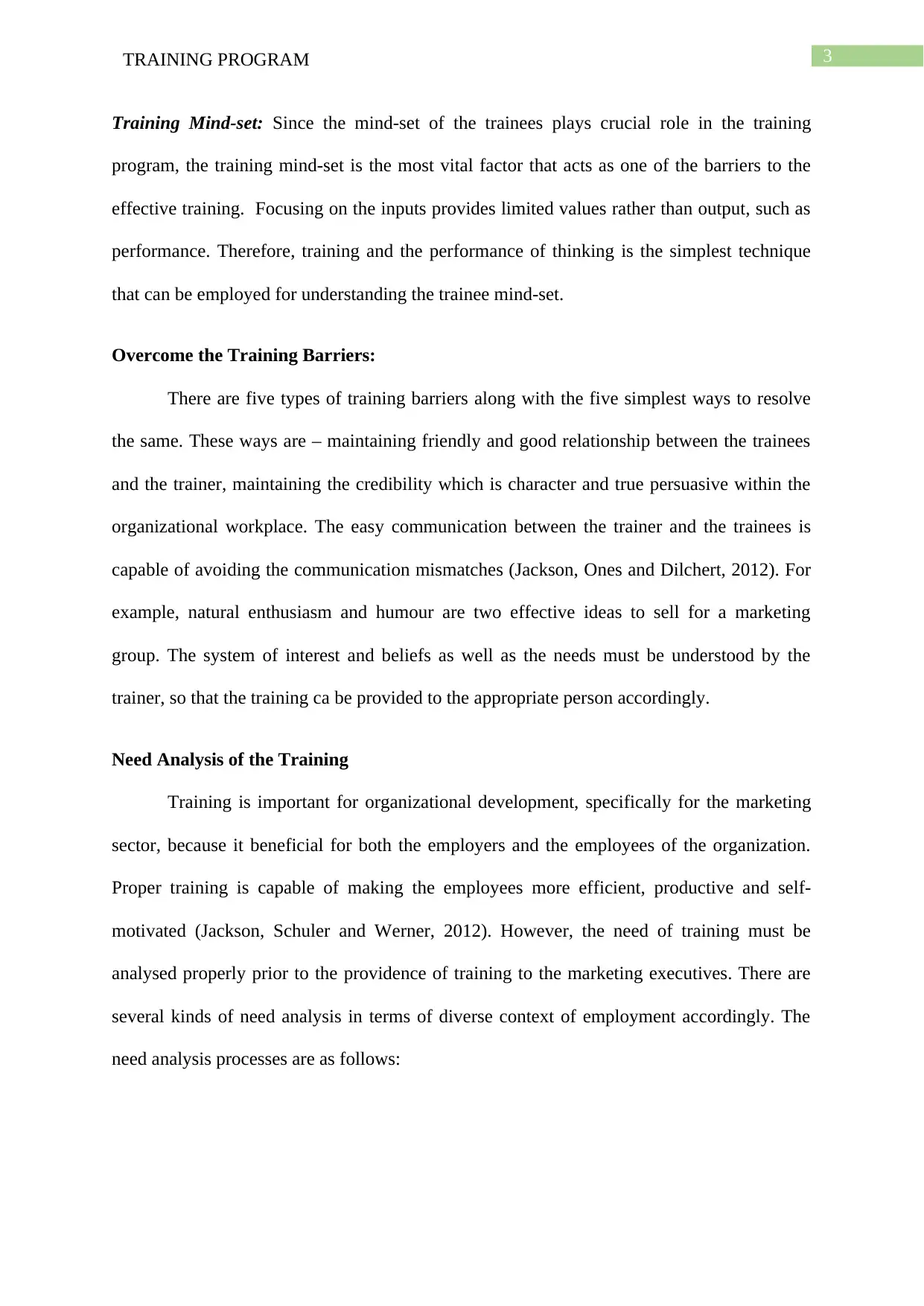
3TRAINING PROGRAM
Training Mind-set: Since the mind-set of the trainees plays crucial role in the training
program, the training mind-set is the most vital factor that acts as one of the barriers to the
effective training. Focusing on the inputs provides limited values rather than output, such as
performance. Therefore, training and the performance of thinking is the simplest technique
that can be employed for understanding the trainee mind-set.
Overcome the Training Barriers:
There are five types of training barriers along with the five simplest ways to resolve
the same. These ways are – maintaining friendly and good relationship between the trainees
and the trainer, maintaining the credibility which is character and true persuasive within the
organizational workplace. The easy communication between the trainer and the trainees is
capable of avoiding the communication mismatches (Jackson, Ones and Dilchert, 2012). For
example, natural enthusiasm and humour are two effective ideas to sell for a marketing
group. The system of interest and beliefs as well as the needs must be understood by the
trainer, so that the training ca be provided to the appropriate person accordingly.
Need Analysis of the Training
Training is important for organizational development, specifically for the marketing
sector, because it beneficial for both the employers and the employees of the organization.
Proper training is capable of making the employees more efficient, productive and self-
motivated (Jackson, Schuler and Werner, 2012). However, the need of training must be
analysed properly prior to the providence of training to the marketing executives. There are
several kinds of need analysis in terms of diverse context of employment accordingly. The
need analysis processes are as follows:
Training Mind-set: Since the mind-set of the trainees plays crucial role in the training
program, the training mind-set is the most vital factor that acts as one of the barriers to the
effective training. Focusing on the inputs provides limited values rather than output, such as
performance. Therefore, training and the performance of thinking is the simplest technique
that can be employed for understanding the trainee mind-set.
Overcome the Training Barriers:
There are five types of training barriers along with the five simplest ways to resolve
the same. These ways are – maintaining friendly and good relationship between the trainees
and the trainer, maintaining the credibility which is character and true persuasive within the
organizational workplace. The easy communication between the trainer and the trainees is
capable of avoiding the communication mismatches (Jackson, Ones and Dilchert, 2012). For
example, natural enthusiasm and humour are two effective ideas to sell for a marketing
group. The system of interest and beliefs as well as the needs must be understood by the
trainer, so that the training ca be provided to the appropriate person accordingly.
Need Analysis of the Training
Training is important for organizational development, specifically for the marketing
sector, because it beneficial for both the employers and the employees of the organization.
Proper training is capable of making the employees more efficient, productive and self-
motivated (Jackson, Schuler and Werner, 2012). However, the need of training must be
analysed properly prior to the providence of training to the marketing executives. There are
several kinds of need analysis in terms of diverse context of employment accordingly. The
need analysis processes are as follows:
Paraphrase This Document
Need a fresh take? Get an instant paraphrase of this document with our AI Paraphraser
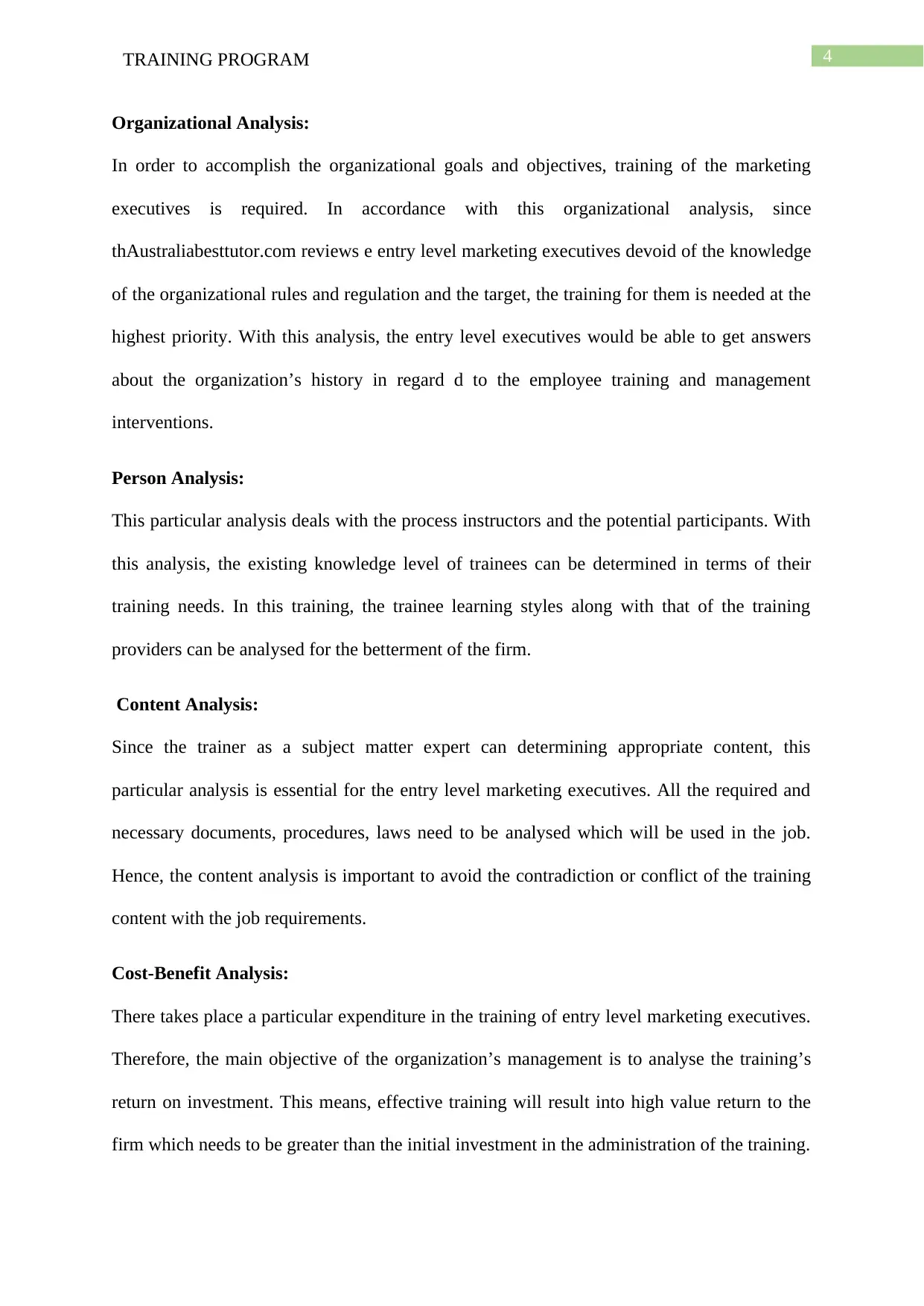
4TRAINING PROGRAM
Organizational Analysis:
In order to accomplish the organizational goals and objectives, training of the marketing
executives is required. In accordance with this organizational analysis, since
thAustraliabesttutor.com reviews e entry level marketing executives devoid of the knowledge
of the organizational rules and regulation and the target, the training for them is needed at the
highest priority. With this analysis, the entry level executives would be able to get answers
about the organization’s history in regard d to the employee training and management
interventions.
Person Analysis:
This particular analysis deals with the process instructors and the potential participants. With
this analysis, the existing knowledge level of trainees can be determined in terms of their
training needs. In this training, the trainee learning styles along with that of the training
providers can be analysed for the betterment of the firm.
Content Analysis:
Since the trainer as a subject matter expert can determining appropriate content, this
particular analysis is essential for the entry level marketing executives. All the required and
necessary documents, procedures, laws need to be analysed which will be used in the job.
Hence, the content analysis is important to avoid the contradiction or conflict of the training
content with the job requirements.
Cost-Benefit Analysis:
There takes place a particular expenditure in the training of entry level marketing executives.
Therefore, the main objective of the organization’s management is to analyse the training’s
return on investment. This means, effective training will result into high value return to the
firm which needs to be greater than the initial investment in the administration of the training.
Organizational Analysis:
In order to accomplish the organizational goals and objectives, training of the marketing
executives is required. In accordance with this organizational analysis, since
thAustraliabesttutor.com reviews e entry level marketing executives devoid of the knowledge
of the organizational rules and regulation and the target, the training for them is needed at the
highest priority. With this analysis, the entry level executives would be able to get answers
about the organization’s history in regard d to the employee training and management
interventions.
Person Analysis:
This particular analysis deals with the process instructors and the potential participants. With
this analysis, the existing knowledge level of trainees can be determined in terms of their
training needs. In this training, the trainee learning styles along with that of the training
providers can be analysed for the betterment of the firm.
Content Analysis:
Since the trainer as a subject matter expert can determining appropriate content, this
particular analysis is essential for the entry level marketing executives. All the required and
necessary documents, procedures, laws need to be analysed which will be used in the job.
Hence, the content analysis is important to avoid the contradiction or conflict of the training
content with the job requirements.
Cost-Benefit Analysis:
There takes place a particular expenditure in the training of entry level marketing executives.
Therefore, the main objective of the organization’s management is to analyse the training’s
return on investment. This means, effective training will result into high value return to the
firm which needs to be greater than the initial investment in the administration of the training.
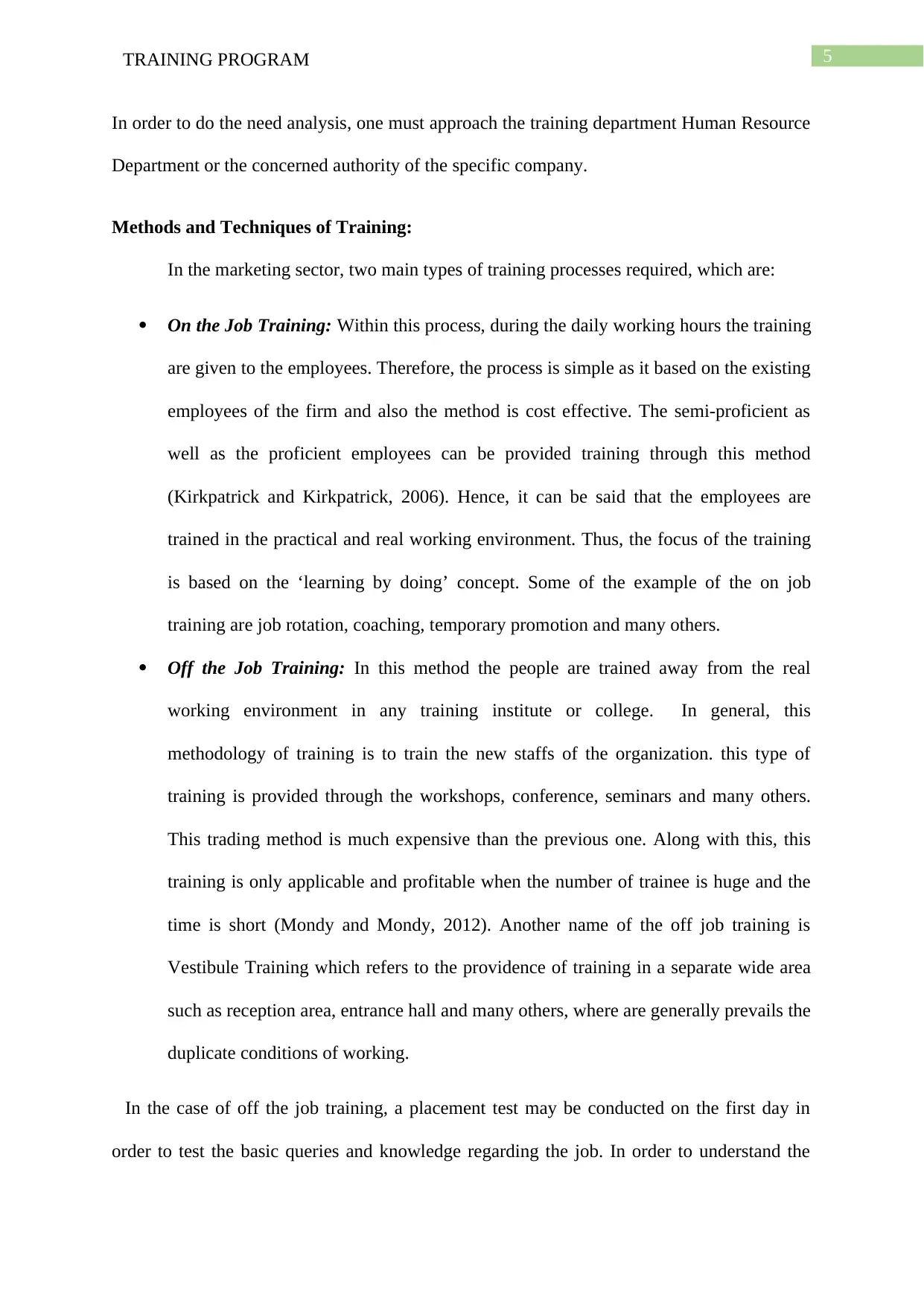
5TRAINING PROGRAM
In order to do the need analysis, one must approach the training department Human Resource
Department or the concerned authority of the specific company.
Methods and Techniques of Training:
In the marketing sector, two main types of training processes required, which are:
On the Job Training: Within this process, during the daily working hours the training
are given to the employees. Therefore, the process is simple as it based on the existing
employees of the firm and also the method is cost effective. The semi-proficient as
well as the proficient employees can be provided training through this method
(Kirkpatrick and Kirkpatrick, 2006). Hence, it can be said that the employees are
trained in the practical and real working environment. Thus, the focus of the training
is based on the ‘learning by doing’ concept. Some of the example of the on job
training are job rotation, coaching, temporary promotion and many others.
Off the Job Training: In this method the people are trained away from the real
working environment in any training institute or college. In general, this
methodology of training is to train the new staffs of the organization. this type of
training is provided through the workshops, conference, seminars and many others.
This trading method is much expensive than the previous one. Along with this, this
training is only applicable and profitable when the number of trainee is huge and the
time is short (Mondy and Mondy, 2012). Another name of the off job training is
Vestibule Training which refers to the providence of training in a separate wide area
such as reception area, entrance hall and many others, where are generally prevails the
duplicate conditions of working.
In the case of off the job training, a placement test may be conducted on the first day in
order to test the basic queries and knowledge regarding the job. In order to understand the
In order to do the need analysis, one must approach the training department Human Resource
Department or the concerned authority of the specific company.
Methods and Techniques of Training:
In the marketing sector, two main types of training processes required, which are:
On the Job Training: Within this process, during the daily working hours the training
are given to the employees. Therefore, the process is simple as it based on the existing
employees of the firm and also the method is cost effective. The semi-proficient as
well as the proficient employees can be provided training through this method
(Kirkpatrick and Kirkpatrick, 2006). Hence, it can be said that the employees are
trained in the practical and real working environment. Thus, the focus of the training
is based on the ‘learning by doing’ concept. Some of the example of the on job
training are job rotation, coaching, temporary promotion and many others.
Off the Job Training: In this method the people are trained away from the real
working environment in any training institute or college. In general, this
methodology of training is to train the new staffs of the organization. this type of
training is provided through the workshops, conference, seminars and many others.
This trading method is much expensive than the previous one. Along with this, this
training is only applicable and profitable when the number of trainee is huge and the
time is short (Mondy and Mondy, 2012). Another name of the off job training is
Vestibule Training which refers to the providence of training in a separate wide area
such as reception area, entrance hall and many others, where are generally prevails the
duplicate conditions of working.
In the case of off the job training, a placement test may be conducted on the first day in
order to test the basic queries and knowledge regarding the job. In order to understand the
⊘ This is a preview!⊘
Do you want full access?
Subscribe today to unlock all pages.

Trusted by 1+ million students worldwide
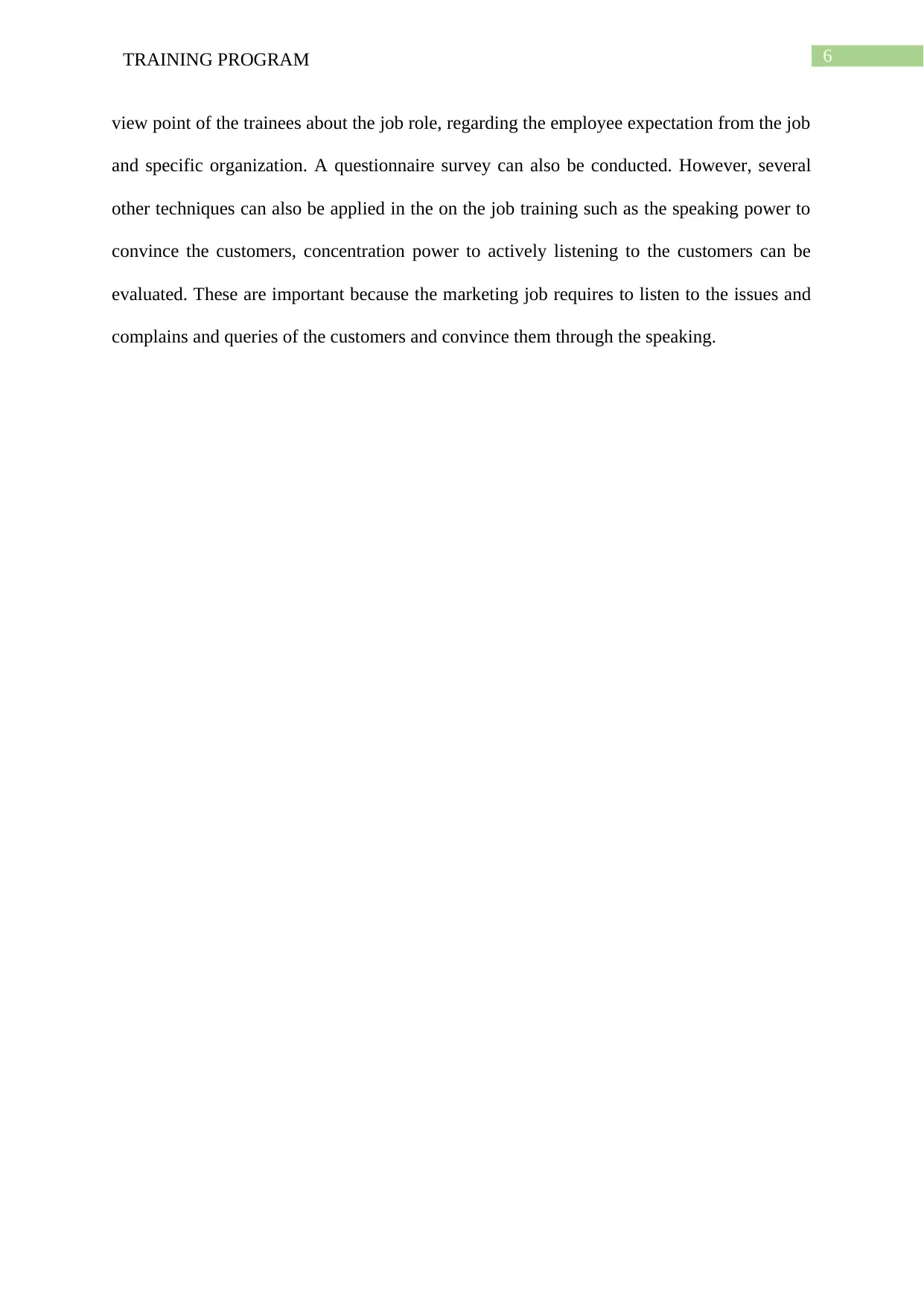
6TRAINING PROGRAM
view point of the trainees about the job role, regarding the employee expectation from the job
and specific organization. A questionnaire survey can also be conducted. However, several
other techniques can also be applied in the on the job training such as the speaking power to
convince the customers, concentration power to actively listening to the customers can be
evaluated. These are important because the marketing job requires to listen to the issues and
complains and queries of the customers and convince them through the speaking.
view point of the trainees about the job role, regarding the employee expectation from the job
and specific organization. A questionnaire survey can also be conducted. However, several
other techniques can also be applied in the on the job training such as the speaking power to
convince the customers, concentration power to actively listening to the customers can be
evaluated. These are important because the marketing job requires to listen to the issues and
complains and queries of the customers and convince them through the speaking.
Paraphrase This Document
Need a fresh take? Get an instant paraphrase of this document with our AI Paraphraser
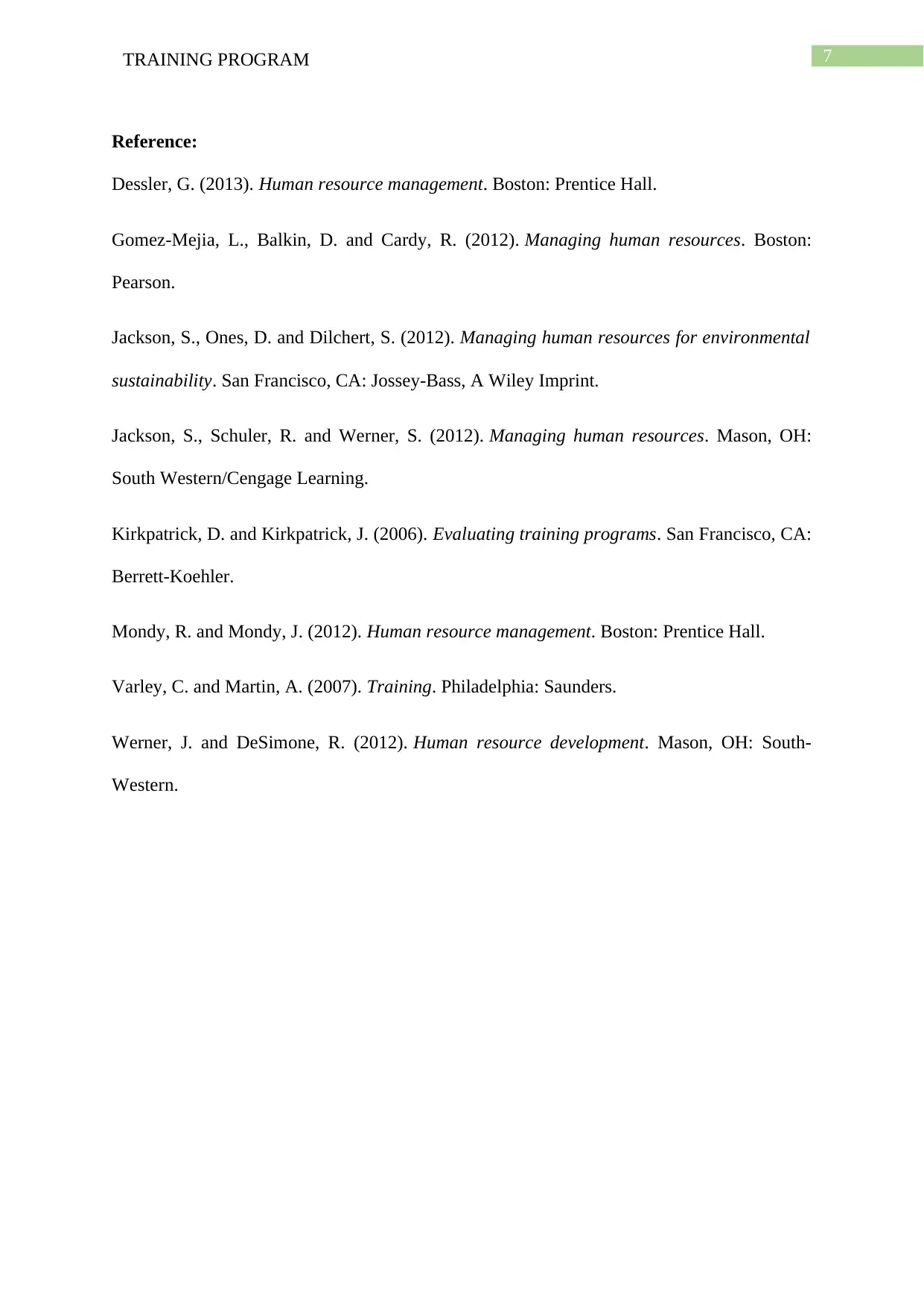
7TRAINING PROGRAM
Reference:
Dessler, G. (2013). Human resource management. Boston: Prentice Hall.
Gomez-Mejia, L., Balkin, D. and Cardy, R. (2012). Managing human resources. Boston:
Pearson.
Jackson, S., Ones, D. and Dilchert, S. (2012). Managing human resources for environmental
sustainability. San Francisco, CA: Jossey-Bass, A Wiley Imprint.
Jackson, S., Schuler, R. and Werner, S. (2012). Managing human resources. Mason, OH:
South Western/Cengage Learning.
Kirkpatrick, D. and Kirkpatrick, J. (2006). Evaluating training programs. San Francisco, CA:
Berrett-Koehler.
Mondy, R. and Mondy, J. (2012). Human resource management. Boston: Prentice Hall.
Varley, C. and Martin, A. (2007). Training. Philadelphia: Saunders.
Werner, J. and DeSimone, R. (2012). Human resource development. Mason, OH: South-
Western.
Reference:
Dessler, G. (2013). Human resource management. Boston: Prentice Hall.
Gomez-Mejia, L., Balkin, D. and Cardy, R. (2012). Managing human resources. Boston:
Pearson.
Jackson, S., Ones, D. and Dilchert, S. (2012). Managing human resources for environmental
sustainability. San Francisco, CA: Jossey-Bass, A Wiley Imprint.
Jackson, S., Schuler, R. and Werner, S. (2012). Managing human resources. Mason, OH:
South Western/Cengage Learning.
Kirkpatrick, D. and Kirkpatrick, J. (2006). Evaluating training programs. San Francisco, CA:
Berrett-Koehler.
Mondy, R. and Mondy, J. (2012). Human resource management. Boston: Prentice Hall.
Varley, C. and Martin, A. (2007). Training. Philadelphia: Saunders.
Werner, J. and DeSimone, R. (2012). Human resource development. Mason, OH: South-
Western.
1 out of 8
Related Documents
Your All-in-One AI-Powered Toolkit for Academic Success.
+13062052269
info@desklib.com
Available 24*7 on WhatsApp / Email
![[object Object]](/_next/static/media/star-bottom.7253800d.svg)
Unlock your academic potential
Copyright © 2020–2025 A2Z Services. All Rights Reserved. Developed and managed by ZUCOL.




